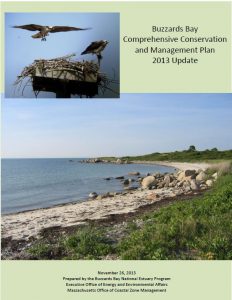2013 CCMP, Action Plan 4:
Improving Land Use Management and Promoting Smart Growth
About the new Buzzards Bay CCMP Action Plans
The Buzzards Bay Comprehensive Conservation and Management Plan (CCMP) was updated in November 2013 to reflect the great progress achieved since the original CCMP was finalized. You can download the entire document (buzzards-bay-ccmp-2013-update.pdf) or just this action plan Improving Land Use Management and Promoting Smart Growth.
Improving Land Use Management and Promoting Smart Growth
Problem
Past building and development practices, coupled with poorly planned local zoning and development requirements, have resulted in sprawl, increased pollution discharges, and many other unintentional injurious ef-fects to the environment. Whereas the Promoting LID action plan focuses principally on stormwater manage-ment and restoring the natural hydrology of sites, “Smart Growth” and similar growth management principles address the broader and indirect environmental impacts of growth and sprawl. Smart growth strategies include planning, zoning, protection of open space, preserving natural landscapes, encouraging village centers, and promoting clustering of development and other actions that cannot be directly addressed through conventional environmental regulations. Implementation of these plans, practices, and policies will not only benefit the environment, but also save government infrastructure construction and maintenance, and ultimately benefit the public with reduced government tax burdens.
Goal
Goal 4.1. To improve land use management through the use of smart growth strategies in the Buzzards Bay watershed to maintain and improve the natural resources and ecology of Buzzards Bay.
Objectives
Objective 4.1. To encourage smart growth techniques in less developed Buzzards Bay watershed communities to preserve open space, revitalize urban and village centers, focus development on growth centers, and protect natural resources and the environment.
Objective 4.2. To improve local zoning, subdivision, health, and wetlands regulations to manage future growth in a way that protects the environment of Buzzards Bay and its watershed.
Objective 4.3. Promote sustainable agriculture that does not adversely affect water quality.
Approaches
Municipalities have a responsibility for regulating and managing the impacts of future growth to minimize potential environmental impacts. Besides project specific permitting requirements, tools available to municipalities include master plans, open space plans, industrial and economic incentive zones, zoning, clustering of development rules, parking space regulations, and decisions about the placement of public infrastructure and public facilities, are all tools that shape and define future patterns of development. How these tools are used also effect the cumulative impacts of growth on the environment. One of the biggest local challenges, however, is simply defining the goals for the preferred patterns of development and redevelopment. Once the goals are better defined, these tools can be used more effectively and in a complimentary way.
The first step is to evaluate local regulations that need to be reexamined. Regulatory strategies may include revisions to zoning bylaws, general bylaws, and local wetland regulations. However, a vision of smart growth strategies and goals must be included in long-term planning documents like municipal master plans, open space plans, and municipal stormwater plans.
Each municipality must decide which smart growth techniques work best for them, and implement those that optimally protect their critical resources and minimize growth impacts on water quality and habitat special to their community. Certain techniques, like cluster zoning, should be universally adopted. Other techniques are more town-specific. The transfer of development rights (TDRs) is a technique underutilized by rural municipalities. For the TDR process to work as desired, municipalities must identify sensitive resource areas (sending areas) and growth centers (receiving areas). Defining the sending and receiving areas can be informed by science (e.g. receiving areas should not adversely affect another area), but assigning these areas may require political and economic considerations.
Other levels of government need to support municipalities through technical and financial assistance programs. Where appropriate, state, and federal government must also change regulations and laws governing new growth and redevelopment to both support smart growth principles, and to lead by example. Regional planning and regulatory agencies, the Buzzards Bay NEP, and state agencies all have important roles to play through training, education, and in the review of projects that meet certain state and regional thresholds.
Costs and Financing
Many of the necessary regulatory changes to implement this action plan have negligible cost to government. More importantly, some smart growth approaches (like clustering of development) also reduce costs to developers and tax burdens to residents because of lesser infrastructure maintenance costs.
Measuring Success
This action plan requires tracking of programmatic measures such as adoption of laws and regulations that achieve the goals of this action plan. This action plan attempts to lessen numerous effects of new development; no one environmental outcome can be tracked directly.
